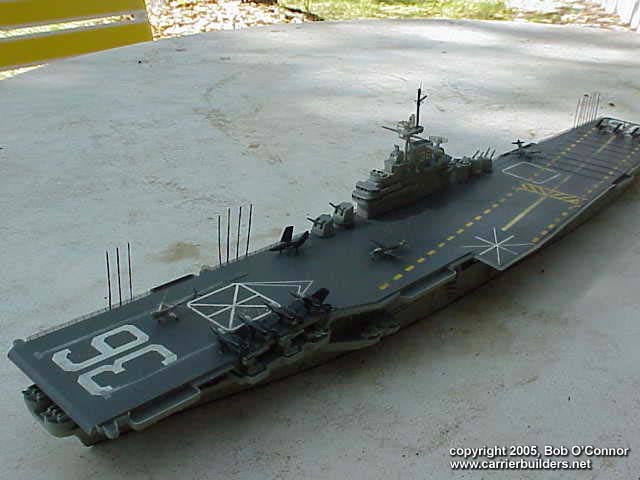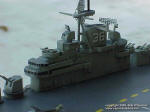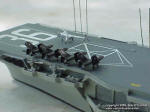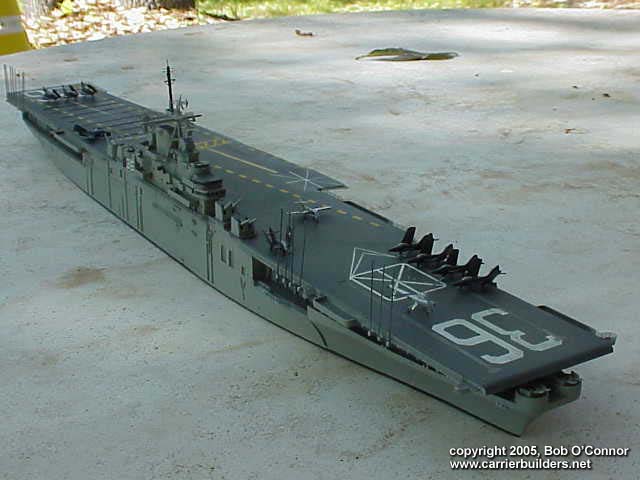|

The USS Antietam was a long hulled Essex class ship, which is probably
most famous for having been the US Navy’s test ship for the angled deck carrier
design. I decided to model that fit, as she appeared in 1953.
Hasegawa’s long hulled USS Hancock kit
served at the basis for this project. The kit is old, and has some
problems. Until recently, it was the only game in town, because the old
Revell kit was terrible, not worth the time.
The kit comes with a few sprues of WWII aircraft- Avengers, Corsairs,
Hellcats and Wildcats. It is also a bit lacking in overall detail in the
gun department; but again, it was the best game in town for so long. A
very generic kit, it needs a lot of cleanup work on the flight deck,
which has raised detail such that the scale planes would shear their
landing gear if they touched down…
I wanted to build Antietam as she
appeared in the many famous photos in 1953, with a “temporary” angled
deck added to test the British concept. Antietam sailed in spring 1953
with this addition, worked the Atlantic coast and even cross-decked some
Royal Navy Fleet Air Arm planes.
Starting with the flight deck, and armed with research drawings and
photos, I stripped the deck of all the raised detail. Using plastic
card, I fashioned an angled deck to run from the fantail out to the
waist elevator, cemented it in place, and puttied and sanded clean. I
also angled the fantail to allow for the differential in the approach of
landing aircraft.
The hull was a straightforward build of the kit- this was before any SCB-
additions were made to the ship (hull bulges/widening and gun removals),
and the deck modifications were considered temporary and removable.
Thus, the kit was built per photos and line drawings, and she was
essentially a WWII-style Essex hull with no mods to the hull visible.
Note this ship still has the original WWII style elevator locations- the
aft elevator still in the middle of the after landing deck area. This
elevator was moved to the starboard side of the ship in subsequent
modifications on all SCB- modified Essex class ships.
The island was modified only to reflect the enclosed bridge areas
(something done on most Essex class ships during or after WWII), and
that was done by removing the kit’ open bridge detail and fashioning a
new one from Evergreen plastic and adding photoetched bridge windows,
then fairing the works onto the island. Any other modifications, such as
the radars, were minor in nature, and are reflective of the photographic
evidence.
|


Click on the images to
enalrge! |
Attaching the flight deck to the hull, I included
the temporary flight deck extension supports below the deck. This deck, unlike
the later permanent deck additions, did not have large sponsons to support the
flight deck. Instead it has a framework of beam supports, angling down from the
edge of the deck’s undersides, into the side of the hull at the hangar deck
level. These are represented by bits of Evergreen strips.
The ship was painted with Model Master paints, then gloss coated and shaded. I
colored the flight deck with a dark grey. I could not determine if Antietam had
a blue or grey flight deck at the time, and I went with the safe choice,
although history tells us U.S. carriers were still sporting both colors.
Markings are a combination of white deck numbers, (to which I should have added
a black shadow. I learned after I decaled the kit- damn!) along with yellow deck
lines and a barrier warning. No real difficulty here, other than the fact that
there are no yellow dashed lines available and I did not want to cut and apply
all those small dashes individually. I compromised, and cut masking tape to
width, then applied it carefully across the yellow lines of the decal sheet. I
sprayed the decal sheet with the deck color, removed the tape, cut the yellow
lined decals to length and applied them. It worked for me….
I used Gold Medal Models and Tom’s Modelworks photoetched parts around the ship-
radars, ladders and railings.
The aircraft are White Ensign Models (WEM) F9F Cougars, a WEM Seahawk cross
decking from a RN flat top, three FJ2 Furies (also WEM). The Helo is a WEM
product also. There is also a lone injection molder F9F Panther. Note the dark
blue paint schemes common to the era- the downside is that the dark aircraft are
difficult to see against the dark flight deck. The upside is that thanks to WEM,
I am able to have correct period aircraft on board. Otherwise, I’d have nothing
but a lone Panther and maybe some Skyraiders.
USS Antietam was an important test ship
for the US Navy. The British concept of the angled deck allowed for
simultaneous launch and recovery of aircraft, and revolutionized carrier
operations. This was a relatively easy conversion, and one that adds
greatly to my collection of those Fabulous Flattops of the Fifties!

|
This model features the
following product available at our sponsors
Click on the item
to see availability! |
 |
|
WEM 1/700
Aircrafts |
Photos and text © 2005 by
Bob O'Connor
May 27, 2005
www.carrierbuilders.net |
